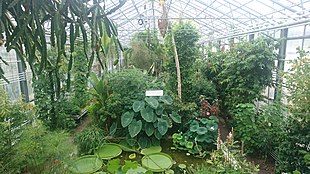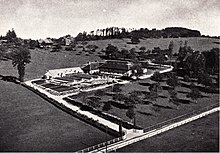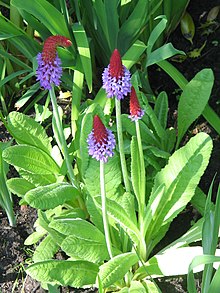St. Gallen Botanical Garden

The St. Gallen Botanical Garden is located in the Neudorf district of St. Gallen at the address Stephanshornstrasse 4. In the open-air site and in several greenhouses, around 8,000 labeled plant species from all over the world are on display. The park-like outdoor area is freely accessible during the day.
history

In 1878 the first botanical garden in St. Gallen was created in the city park on the east side of the nature museum, which was opened the previous year . Its first director, the botanist and plant collector Friedrich Bernhard Wartmann , wanted to supplement the objects exhibited in the museum with a living collection of plants. Together with his friend, the botanist and educator Theodor Schlatter (1847–1918), he created a 6000 m² facility, which also included an alpine area . In 1918 most of this show garden was destroyed because the new historical museum was to be built there.
The second botanical garden in St. Gallen was laid out at a replacement site near the present day teacher training college . This fell victim to construction projects in 1934.
The groundbreaking ceremony for today's botanical garden took place on June 16, 1945 in the Stephanshorn area in Neudorf, where the city nursery had been located for decades. In the beginning, numerous school classes from St. Gallen and their biology teachers took part in the design of the new garden, especially Paul Zülli, who was then head of the horticultural office. In the course of the following decades, the city of St. Gallen, as the owner, continuously expanded the facility. In 1993 the botanical garden received an architecturally remarkable alpine house ; a new tropical house was built in 1998 and the orchid house was added in 2007 . The outdoor area was completely renovated in 2011.
description
Outdoor area
The outdoor area of the St. Gallen Botanical Garden comprises 20 different departments, which are connected by walking paths. A pergola and benches invite you to linger. In the assortment departments you can see ornamental cherries and maple trees , a perennial garden , an iris garden and borders with roses , daffodils and barberries , a rock garden on raised beds , a fern garden , potted plants and a water garden as well as some beds with changing themes. In the useful plants departments , poisonous and medicinal plants , cultivated plants and grasslands are shown.
Geographic departments
In the four geographical sections Alpinum , Europe , America and Asia , typical plants of the respective regions are presented. The Europe section shows the diversity of the native Swiss flora and the wide range of flora in the very different European climatic zones in terraced beds. In the America department, you can experience a small Indian summer in autumn with the brightly colored leaves of the American trees and shrubs planted there .
In the geographical department Asia , 400 plant species grow from steppe, forest and mountain areas in various Asian climatic zones . In the center of this department is a small Japanese garden with a small pond and a stone lantern, which was modeled on a model from the Kaisergarten. One of the most popular places to stay in the botanical garden is the pergola located there , which is densely covered with Asian climbing plants . This area is particularly attractive during the blooming time of the orchid primrose ( Primula vialii ), which has its natural location in the Chinese provinces of Yunnan and Sichuan and was planted here by the hundreds.
The Alpinum department is mostly located on a slight slope and consists of two different areas. For the Alpinum Säntis area , limestone blocks were used to create rock areas for species of the alpine level. Low-growth birch species and subalpine tall perennials grow on the banks of a small pond . In Alpinum Swiss Alps contrast, older conifers as dominant Arve ( Pinus cembra ) and mountain pine ( Pinus mugo ). An area with Verrucano rock was created for alpine plants that require neutral to acidic soil conditions .
School departments
The three school departments with the areas of biology , genetics and systematics supplement the theoretical knowledge of the visitors in the practical object lesson. With the help of typical living plants, the Biology department provides information on the subjects of flower biology , dispersal biology and the special diets of plants.
In the Genetics department , the laws governing the inheritance of plant properties on the offspring with corresponding plants are presented. In the center of the department is the Mendel Garden named after Gregor Mendel with mutations of various trees and shrubs.
In the systematics department , around 500 different flowering plant species from 100 plant families are shown. This area was comprehensively renewed and re-labeled in 2013/2014 due to new scientific findings regarding the relationships between the plant species and the resulting renaming.
Greenhouses
In a large tropical house built in 1998 with two water basins and a grandstand , plants from the rainforest , succulents and useful plants such as cinnamon, coffee and vanilla are shown. A special attraction is the basin with the Victoria - water lily . In 2007 an orchid house was added to the tropical house . The alpine flora is housed in an alpine house, which was built in 1993 with an unusual architecture. There is also the small carnivore house , an extra greenhouse for carnivorous plants and a lithop house in which living stones are shown.
Orangery
The orangery is a striking, well-preserved historical building with a red tiled roof, which was built on this site in 1914 together with other buildings for the then municipal gardening company. Its special architectural features are the visible supporting structure made of beams glued according to the Hetzer principle and the attached lantern , which ensures better incidence of light. Between October and May the potted plants hibernate in the orangery at a temperature of around 5 ° C. In the summer months, exhibitions on natural history topics and other events take place here.
Activities and offers
On the first Sunday of each month, there are regular public tours through the outdoor area and the greenhouses. Special tours can be booked for a fee. Numerous public events such as lectures, readings, exhibitions and courses take place throughout the year. In addition to a sponsors' association , the St. Gallen Botanical Circle also supports the organization and implementation . Once a year the botanical garden organizes an all-day garden party. A public plant exchange market takes place every autumn .
The St. Gallen Botanical Garden is itself a member of the Hortus Botanicus Helveticus association and as such also participates in the BOTANICA initiative - the last of their kind , a four-week series of events organized by 20 botanical gardens in Switzerland, with which it is based on its contribution to the preservation of the Want to draw attention to biodiversity .
During the mushroom season , the St. Gallen Botanical Garden acts as a public mushroom advice center at certain times of the day from August to October and offers free identification and control of privately collected edible mushrooms .
The grandstand in the tropical house can be rented for private events with up to 50 people.
Support association
One year after the last reconstruction of the botanical garden, the non-profit association Friends of the Botanical Garden St. Gallen was founded in 1946 with the aim of promoting the institution ideally and materially. This happened, among other things, through his participation in the financing of new greenhouses and renovation work in the outdoor departments. The friends' association supports the botanical garden with public relations, finances publications and organizes its own events, the proceeds of which benefit the garden.
Publications
The long-time director of the institution, Hanspeter Schumacher, published a guide through the botanical garden in 2013 with the title The Botanical Garden of St. Gallen: A place of relaxation, education and meeting . In addition, the botanical garden publishes a monthly information sheet in A4 format; In these monthly sheets , a specific plant theme is dealt with comprehensively. The multi-page notifications with news, program information and reports on past and planned activities appear every month .
Works of art

Works of art can be found at various locations in the outdoor area, such as the 1957 sculpture Pan by the Swiss sculptor Wilhelm Meier , whose works can be found in many parts of the city. The entrance area to the botanical garden by the sliding gate on Stephanshornstrasse was designed with several large, artistically processed shelves made of Rorschach sandstone .
Planet path
The botanical garden is also the starting point of the St. Gallen Planet Trail , which was built in 1979 and leads from here via Mörschwil to Obersteinach . The starting point of this 8 km long themed hiking trail is the model of the sun next to the tropical house. The hiking trail leads inside the garden past the scale models of Mercury and Venus to the earth and moon .
literature
- Hanspeter Schumacher: The St. Gallen Botanical Garden: place of relaxation, education and meeting. Appenzeller-Verlag, Herisau 2013, ISBN 978-3-85882-664-0 .
Web links
- Literature from and about the St. Gallen Botanical Garden in the WorldCat bibliographic database
- The St. Gallen Botanical Garden on the website of the City of St. Gallen
Individual evidence
- ↑ Toni Bürgin, Jonas Barandun: Nature Museum St. Gallen: Collected Nature - yesterday, today, tomorrow. Naturmuseum St. Gallen (Ed.), St. Gallen 2003, p. 15. Online
- ↑ a b c History of the Botanical Garden. City of St. Gallen, accessed on September 30, 2018 .
- ^ Hortus Botanicus Helveticus. (No longer available online.) In: botanica-suisse.org. January 27, 2018, archived from the original on January 14, 2017 ; accessed on September 30, 2018 . Info: The archive link was inserted automatically and has not yet been checked. Please check the original and archive link according to the instructions and then remove this notice.
- ↑ BOTANICA. In: botanica-suisse.org. Retrieved September 30, 2018 .
- ↑ Oskar Keller: Our solar system. A guide to the St. Gallen-Steinach (Bodensee) planetary hiking trail. Separately printed from: Reports of the St. Gall Science Society. Volume 91, St. Gallen 2008. Online
- ↑ Themed trails: Planet Trail. City of St. Gallen, accessed on September 30, 2018 .
Coordinates: 47 ° 26 '23.6 " N , 9 ° 24' 27.1" E ; CH1903: seven hundred and forty-eight thousand five hundred and five / 256205
